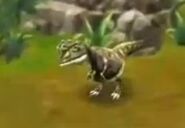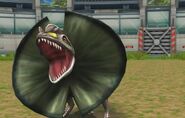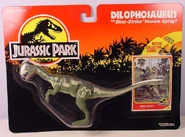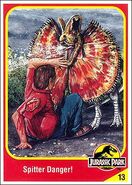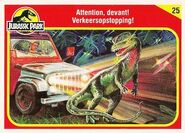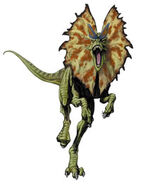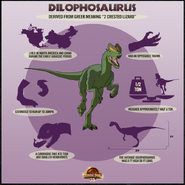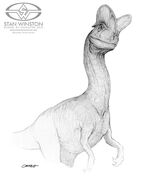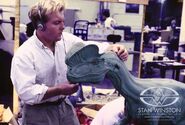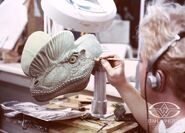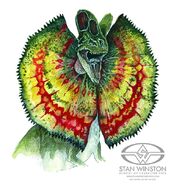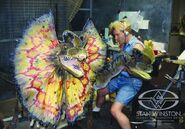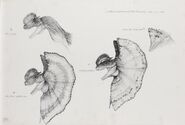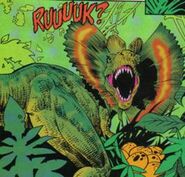This article contains information taken from the (removed) Jurassic Park Institute site
Dilophosaurus was one of the largest carnivorous dinosaurs of the Early Jurassic Period. Dilophosaurus gets its name from the two thin crests of bone on the top of its head. These were probably used as a display for courtship purposes (it's unlikely that it had a frill like the movie suggests). Dilophosaurus has been found in both the U.S. and China, which, although part of the same huge landmass, were still quite a long distance from each other.
As a more primitive predatory dinosaur, Dilophosaurus didn't have forward facing eyes to give it stereo vision. It may have used scent as an integral part of its hunting technique. It had long and slender, rear-curving teeth in long jaws and strong front arms which would have been effective in grabbing prey. It was fast - probably with a top speed of about 30-mph. It also had a long tail that could have been used as a whip in a fight. Footprints attributed to Dilophosaurus appear in groups, so it may have hunted in small packs. It shares the same overall body configuration as its ancestor Coelophysis.[4]
| Wikipedia has a more detailed and comprehensive article on Dilophosaurus |
Appearance

Dilo's Head Concept Art
In most Jurassic Park media Dilophosaurus is portrayed as a 6 meters long predator. Dilophosaurus is one of the least understood dinosaurs. Michael Crichton, Steven Spielberg and Mark "Crash" McCreery filled this data vacuum with their own imagination. Therefore the creature that appears in the Jurassic Park series has some characteristics for which there is either no scientific evidence or contradicts existing data. Jack Horner said that "Dilophosaurus is a good one to make a fictional character out of, because I think two specimens are known, and both of them are in really poor condition. They're not preserved very well."[5]
Sexual dimorphism
The pair of rounded crests on the skull of Dilophosaurus were possibly used for display. In the novel the crests have red and black stripes,[6] one sex (maybe male) has darker crests than the other. One sex is also smaller than the other.[7] Studies by Robert Gay show no indication that sexual dimorphism was present in the skeleton of Dilophosaurus, but says nothing about crest variation.
Venom

Dilo venom.
The connection between the premaxillary and maxillary bones of the skull was very weak. This created a notch behind the first row of teeth. This conformation led to the early hypothesis that Dilophosaurus scavenged off dead carcasses, with the front teeth being too weak to bring down and hold large prey.
So the "Dilophosaurus" in the Jurassic Park franchise deals with that issue by paralyzing its prey by spitting blinding venom in the eyes (like a Spitting cobra). It's said in the Jurassic Park novel that it's venom contains seven different enzymes.[8] The reach of the venom varies: in the Dinosaur Encyclopedia in the Jurassic Park DVD extras and in the Dilophosaurus Jurassic Park: The Game video it can spit distances of 20 feet, but in the novel it can spit up to 50 feet.[8] In this way the creature is still a predator despite it's weak jaws and teeth.
There is no evidence that "Dilophosaurus" had venom glands in reality, but glands don't have structures that are hard enough to fossilize. These venom glands don't contradict any existing data about "Dilophosaurus" fossil discoveries.

Dilo's Profile Concept Art
However, since the dinosaurs of Jurassic Park are recreated some have explained Dilo's ability to spit as an error in its creation. Dr. Holtz and Dr. Brett-Surman claim that "the frill, the T. rex-like skull, and the poisonous spit were clearly the result of DNA plicing by InGen".[9] This explanation found its way into the franchise. Laura Sorkin writes in her journal: "Wu's amphibian DNA has profoundly changed our Dilophosaurs. I'm even wondering if the frill and spitting behavior are a splicing error. There's no evidence in the fossil record for that business."[10] Ironically, Sorkin's Troodon (in which creation no non-Troodon DNA was used) is also poisonous, for which there is no fossil evidence.
Neck frill
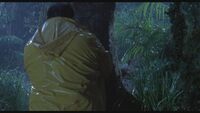
The Dilophosaurus hiding behind a tree.
Steven Spielberg added another dubious feature to the Dilophosaurus: a retractable neck frill around its neck (much like the frill-necked lizard of Northern Australia). It is not considered accurate by paleontologists that Dilophosaurus had a frill. As noted above, in Sorkin's journal and the Dinosaur Field Guide this frill is explained as a result from Henry Wu's use of non-dinosaur DNA while filling the sequence gaps.
Bret Bennington wrote about the frill in the American Paleontologist:
"If Dilophosaurus did have a frill, we would know about it. There would be fossil evidence of bones or some other rigid structure required to hold the frill up and there would be markings on the bones of the neck indicating where muscles could attach that would be required to move the frill up and down. We don't see either of these."[11]

Jurassic Park Franchise

Jurassic Park features a juvenile Dilophosaurus which made up for its small size with a waving frill, and a highly corrosive venom that temporarily blinded its prey, eventually causing paralysis. While it is only seen in Jurassic Park, it has been used on many different items of merchandise for The Lost World and Jurassic Park III. Though living on Isla Sorna it was never seen in the movie.
Novels
Jurassic Park novel
The Dilophosaurus is first seen during the Park Drive near the river. They see one animal, drinking from the river. It is a 10 foot tall carnivore, with a heavy tail, strong hind limbs, and a long neck. Its crests make a V shape above the animal's head. The crests are red and have black stripes, like a parrot or toucan. Its body is covered with yellow and black spots, like a leopard, with a light green belly. It has a hooting that sounds like an owl.[6][12]
Nedry's death
In the chapter "Nedry", Dennis Nedry is on his way to smuggle Dinosaur embryos out of the Park. He has taken a wrong turn and instead of the sea he has reached the river (near the Dilophosaurus territory). When Nedry tries to get back to his car he hears a hooting noise. Then he is confronted by the large and dangerous Dilophosaurus. Dennis is first blinded, then his gut is ripped open, and finally the creature puts his jaws around his head.
Nedry's body is later found by Muldoon and Gennaro, with Muldoon remarking "They blinded him, then ripped him down the middle. Not a nice way to go. Maybe there's justice in this world after all."
River Adventure
Because no frog DNA was used to clone the Dilophosaurs they don't reproduce in the first novel. However, in the first novel Grant sees a couple of Dilophosaurus (both male and female) at the river, which were performing a mating ritual. This seeming contradiction is never explained.
End
In the chapter Under Control it is revealed that three Dilophosaurus have died during the park incident.[13] They might have been hunted and killed by the raptors or the Tyrannosaurus after they escaped. All the Dilophosaurus are killed during the Costa Rica Napalm Bombing.
The Lost World
The Dilophosaurs are never seen or mentioned in Jurassic Park's sequel, The Lost World. However, they might have died out due to their lack to reproduce, or just nesting in a different region of Isla Sorna.
Film canon
thumb|300px|right The Dilophosaur in Jurassic Park is a small animal. The video on the Tour the Island website states that the Dilophosaurs of the park are juvenile, with an adult size expectancy of nearly 20 feet.
In The Game episode Dilo Fight! a Dilo is seen close to a nest of eggs. If this was the nest of the Dilo, it would mean that the Dilo's of Jurassic Park are adults. Dr. Laura Sorkin notes that "Wu's amphibian DNA has profoundly changed our Dilophosaurs. They should grow to six meters long. None in our brood are that big."[10]
Jurassic Park film

Entrance of the Dilophosaur Pen

Stalking Nedry

The Dilophosaur Paddock is the first paddock the endorsement team visits on their ride through the park. However, the creature isn't seen. Later in the film, Dennis Nedry saw the Dilophosaurus and tried to make it go away. Angered by the insults Dennis said, the Dilophosaurus lets its frills out and spat venom at him. While Dennis wasted some time getting the venom off his face, the Dilophosaurus seized it's moment and jumped in the car before Dennis closed the door. Dennis was later maimed and killed by the Dilophosaurus as he attempted to bring the stolen embryos to the East Dock. In the less gruesome of the two versions, in the film Nedry's death is shown as him being blinded by the Dilophosaurus venom, and then stumbling into his Jeep where he is met by the Dilophosaurus, which pounced on him from the passenger seat. The camera then cuts to the outside of the Jeep as it rocks back and forth as Nedry yells and screams. In the novel, he suffered a much more gruesome death, as he actually held his intestines in his hands before realizing where he'd been hit.

Nedry's Plan Goes Awry Scene - Jurassic Park Movie (1993) - HD
Jurassic Park: The Game
Dilophosaurs play a major role in the film's sequel Jurassic Park: The Game. The Dilophosaurs first appear in the Nedry's Clearing scenario when Nima is investigating near Nedry's Jeep. A Dilophosaurus is feeding on Nedry but it runs away when Nima appears. This most likely is the same Dilo that killed Nedry.
Nima and Miles Chadwick are attacked by a group of Dilo's in the following Dilo Encounter scenario. Miles is killed by the Dilo's but Nima manages to escape when a pack of Troodons come scaring the Dilophosaurus away.
Dilophosaurus appears in the title screen of Episode 2: The Cavalry.
In the scenario Dilo Fight!, Billy Yoder is attacked by a Dilo and almost killed. Oscar Morales kicks the dinosaur off Billy. Just as Oscar is about to kill the dilo, Yoder stops him because he does not want to see it hurt.
All Dilos on Isla Nublar were presumably killed during the Napalm bombing.
The Lost World: Jurassic Park

Dilophosaurus is also depicted on the screen saver and in the trailers of The Lost World, confirming its presence on Isla Sorna, but they were never seen in the actual film.
In Jurassic Park ///, on a chart in the abandoned labratory. The Dilophosaurus (along with many other dinosaurs) can be seen. It also proving that Dilophosaurus lives on Isla Sorna.
Video games

Dilo in NES game
All of the games used the juvenile Dilophosaurus seen in the first film to depict adult Dilophosaurs.
NES game
Dilophosaurus appeared in the NES game Jurassic Park. It jumps from behind trees, objects, walls and spits poison.
SNES game
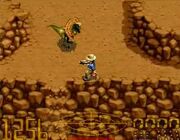
Dilo in the SNES game
Spitting Dilophosaurs are an enemy in the SNES game Jurassic Park. Their spit doesn't cause a lot of damage and they can be easily killed. The creature is seen in more detail inside buildings.
Sega Genesis game
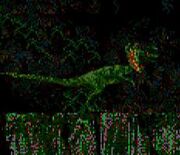
Dilophosaurus in JP Sega Genesis
- Dilophosaurs are an enemy in the Jurassic Park (SEGA Genesis Game).
Jurassic Park Interactive
Spitters are an enemy in the game Jurassic Park Interactive.
Jurassic Park (arcade game)
Dilophosaurs are encountered in Area 1 and 4 in the arcade game Jurassic Park.
Chaos Island
Spitters appear in Chaos Island: The Lost World. They are the only dinosaurs in the game with ranged attack.
The Lost World: Jurassic Park (arcade game)

Dilophosaurus in The Lost World (arcade game)
Few Spitters are encountered in the Stage 1 of the arcade game The Lost World: Jurassic Park.
Dinosaur Battles
In the PC game Jurassic Park Dinosaur Battles Dilophosaurus is an opponent. It is a fast opponent, advanced Dilophosaurs have strong piercing attacks. The Dilophosaurus cannot be obtained in the game, as with the Gallimimus.
Island Attack
Dilophosaurus is an enemy in Jurassic Park III: Island Attack, in the level The Laboratory the player has to defeat a pack of Dilophosaurs in a boss fight.
Jurassic Park III: Park Builder

Dilophosaurus from Jurassic Park III: Park Builder
The creature is nr. 008 of the Carnivore Twos that can be created in Jurassic Park III: Park Builder.
Jurassic Park III: The DNA Factor
In Jurassic Park III: The DNA Factor Dilophosaurus is one of the 12 encountered dinosaurs on Isla Sorna.
Jurassic Park III (arcade game)
In the arcade game Jurassic Park III Dilophosaurus appears in Areas 1 and 4.
Jurassic Park: Explorer
Dilophosaurus is featured in the DVD game Jurassic Park: Explorer. A player earns a dinosaur when he/she wins a minigame, when the earned dinosaur is a Dilophosaurus this video will be shown. The video shows that the animal is 7 meters (23 ft) long, as it was in reality, but it still has the neck frill.
Jurassic Park: Builder
Dilophosaurus is one of the available dinosaurs on the IOS application, Jurassic Park: Builder. It should be noted in Builder that, when tapped, the Dilo exposes it's frill and roars. When it is young, it sounds like a raptor, and when adult, its sound is that of a T. rex.
In the Battle Arena of Jurassic Park: Builder the Dilo looks similar in size to the Velociraptor, suggesting that the one from the movie is not fully grown.
Jurassic Park: Operation Genesis
see Dilophosaurus/Operation Genesis

Dilophosaurus in Jurassic Park: Operation Genesis.

Dilophosaurs appear Jurassic Park: Operation Genesis as a two-star small carnivore, the game's Dilophosaur shares all of the characteristics of the one in the movie, from the frill to the small stature. It can spit venom at prey but does not, however, spit venom at the visitors, despite the spaces between the bars on the fence. If not in the fence though, they then can hunt visitors, as well as cleaners, even though the cleaners will most likely never be killed by the dinosaurs, no matter how many times they've been hit by venom. This is most likely a game play error, or the cleaners are wearing venom proof clothing. The Dilophosaurus (the weakest of the small carnivores) will only attack and kill small herbivores such as Dryosaurus, Homalocephale, and Gallimimus and is unable to take down large or armoured small herbivores. They can be placed along with Velociraptor in one enclosure as long as they are not rampaging. They can even be placed with non aggressive herbivores such as Edmontosaurus.

Dilophosaurus info in JP:OG
toy lines
Dilophosaurus appeared in almost every JP toy line except the Chaos Effect toy line even though Dilophosaurus did sort of appear as part of the Dilophospinus, and later was going to appear in the unreleased Chaos Effect Night Hunter toy line. A new Dilophosaurus figure was going to be sold as apart of a 2 pack in the jurassic park 2011 toyline along with a stegosaurus but was ultimatley cancelled there is a possibility of it being released in a future toyline
Trading Cards
Gallery
In popular culture
The Jurassic Park depiction of Dilophosaurus has been taken up by others. Several other video games, such as ParaWorld, Jurassic: The Hunted, Nanosaur, Ice Age: Dawn of the Dinosaurs, feature Dilophosaurus modeled after the representations in Jurassic Park. In Primal Carnage the Dilophosaur can spit poison over long distances, but it doesn't have a frill.
The Whitest Kids U'Know sketch "Dinosaur Rap" (a music video for Trevor Moore's "Gettin' High With Dinosaurs") features a Dilophosaurus, complete with a short frill.
Trivia
- Dilophosaurus, along with Procompsognathus and Troodon, are the only known venomous dinosaurs in the Jurassic Park franchise.
- The Dilophosaurus is the only dinosaur to appear in the movies that did not use CGI, only using animatronics.
- Dilophosaurus may have roved in packs, since there was 3 fossils found together. This said to be true in Jurassic Park: The Game. This is also shown in Jurassic Park: Operation Genesis hunting in small packs about 2-5.
- It is possible that only juvenile Dilophosaurus have the frill, since in the novel while it still possesses the venom, it is its accurate size without the frill. Because of their small size, they would be an easy target for larger predators, and they use the frill to intimidate their enemies. As they grow larger, they no longer need such self-defense, as adult Dilophosaurus were very large and powerful animals that were quite capable of defending themselves. This is confirmed in Jurassic Park; The Game.
- In Dr. Laura Sorkin's journal in Jurassic Park: The Game, she confirms the suspicions of Dr. Wu's frog DNA being what caused Dilophosaurus to be so dissimilar from the fossil record.
- Three appear on Jurassic Park: The Ride (Hollywood)
- Dilophosaurus lived during the early Jurassic Period, before mosquitos are currently confirmed by the fossil record to exist. If Jurassic Park was able to find any viable DNA specimens, there would have been very little to go on. This would mean that there would be more gaps than normal in the DNA sequence, subsequently filled by more frog DNA. This could explain why the Dilophosaurus are so different from their Prehistoric counterparts, far more so than other dinosaurs.
References
- ↑ 1.0 1.1 1.2 Dinosaur Field Guide, page 64.
- ↑ InGen Field Guide, page 16.
- ↑ 3.0 3.1 Seen on computer in Trailer, see picture in text.
- ↑ Dinopedia on the JPI site
- ↑ Cristy Lytal, 'Jurassic Park' paleontologist offers advice on ways of dinosaurs, Los Angeles Times, March 31, 2013, 6:00 a.m.. link
- ↑ 6.0 6.1 Jurassic Park (novel), Control, page 142
- ↑ Jurassic Park (novel), page 300
- ↑ 8.0 8.1 Jurassic Park (novel), page 147
- ↑ Dinosaur Field Guide, page 65.
- ↑ 10.0 10.1 InGen Field Journal#Dilophosaurus
- ↑ American Paleontologist
- ↑ Jurassic Park (novel), Nedry (chapter), page 195.
- ↑ Jurassic Park (novel), Under Control, page 368
Template:JPI Dinosaurs









